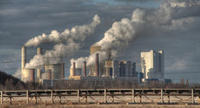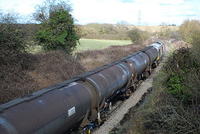-
Texas acts to reduce number of man-made earthquakes
The number of disposal wells in Texas has surged along with the number of drilling projects. Texas has more than 3,600 active commercial disposal wells. In 2013, the Railroad Commission approved 668 disposal well permits, twice the number of approvals in 2009. The growing number of disposal wells corresponds with an increase in earthquakes in communities where such seismic activity rarely existed.Officials in Texas have now taken steps to reduce the number of earthquakes caused by wells drilled for the disposal of oilfield waste.
-
-
State regulators discuss the connection between fracking and earthquake
Regulators from states with significant petroleum and natural gas exploration activities met last week in Columbus, Ohio as part of the 2014 Interstate Oil and Gas Compact Commission conference.One key topic of discussion at the conference wasthe potential implications of a study which found that numerous, unnoticeable earthquakes in Harrison County, Ohio, likely were linked to oil and natural gas exploration. 190 of the quakes which ranged from magnitude 1.7 to 2.2, occurred in the thirty-nine hours after fracking activity occurred at one well in late September and early October 2013.
-
-
Getting the salt out
The boom in oil and gas produced through hydraulic fracturing, or fracking, is seen as a boon for meeting U.S. energy needs. But one byproduct of the process is millions of gallons of water that’s much saltier than seawater, after leaching salts from rocks deep below the surface. Study shows electrodialysis can provide cost-effective treatment of salty water from fracked wells.
-
-
A boom in global natural gas, by itself, will not slow climate change
A new analysis of global energy use, economics, and the climate shows that without new climate policies, expanding the current bounty of inexpensive natural gas alone would not slow the growth of global greenhouse gas emissions worldwide over the long term. Because natural gas emits half the carbon dioxide of coal, many people hoped the recent natural gas boom could help slow climate change — and according to government analyses, natural gas did contribute partially to a decline in U.S. carbon dioxide emissions between 2007 and 2012. In the long run, however, according to this study, a global abundance of inexpensive natural gas would compete with all energy sources — not just higher-emitting coal, but also lower-emitting nuclear and renewable energy technologies such as wind and solar. Inexpensive natural gas would also accelerate economic growth and expand overall energy use.
-
-
Hydraulic fracturing caused earthquakes in Ohio
Hydraulic fracturing triggered a series of small earthquakes in 2013 on a previously unmapped fault in Harrison County, Ohio, according to a new study. This series of earthquakes is the first known instance of seismicity in the area. Hydraulic fracturing, or fracking, is a method for extracting gas and oil from shale rock by injecting a high-pressure water mixture directed at the rock to release the gas inside. The process of hydraulic fracturing involves injecting water, sand and chemicals into the rock under high pressure to create cracks. The process of cracking rocks results in micro- earthquakes.
-
-
Debate continues over releasing Pennsylvania crude oil shipment information
Shipment of crude oil by rail in the United States has increased from 800,000 barrels a day in 2012 to 1.4 million in 2014. In western Pennsylvania, over seventy-five million gallons of crude oil are passing through Allegheny and Westmoreland counties to refineries in Philadelphia. Release of the recently classified rail transport records by Pennsylvania Emergency Management Agency (PEMA) was a result of a federal mandate ordering railway companies to share information on interstate shipments of crude oil with state emergency management officials.Railway companies claim that releasing the information threatens security and is commercially sensitive.
-
-
Reliance on BP, feeble regulations make U.S. partially culpable in Deepwater Horizon oil spill
A recent ruling by a federal judge that BP was “grossly negligent” in the 2010 Deepwater Horizon oil rig spill in the Gulf of Mexico placed the majority of blame on the multinational oil and gas company. Although not on trial in this case, the federal government was also culpable in the largest oil spill in U.S. history, according to a new paper. Based on reports from the National Commission on the BP Deepwater Horizon Oil Spill and Offshore Drilling, the Chief Council’s Report and other government documents, the report’s authors determined that the government’s reliance on market-based accountability mechanisms and its failure to implement a regulatory process based on a mutually agreed upon set of robust standards and voluntary information disclosure led to the largest oil spill in U.S. history.
-
-
Smart grid needed to shift electrical system to alternative energy: Expert
Solar, wind, and other alternative sources are easier on the environment but less predictable than coal, gas, or oil-fired plants, demanding a more sophisticated distribution and delivery system. A more resilient, responsive electrical grid – a smart grid – would adjust electrical loads to energy demands, preventing the shutdowns that leave people without air conditioning just when they need it most. A smart grid is thus a flexible grid – it is an infrastructure which allows shifting load and demand around effectively, ultimately balancing the electrical power and delivery system at lower costs.
-
-
Fusion reactor concept could be cheaper than coal
Fusion energy almost sounds too good to be true — zero greenhouse gas emissions, no long-lived radioactive waste, a nearly unlimited fuel supply. Perhaps the biggest roadblock to adopting fusion energy is that the economics have not penciled out. Fusion power designs aren’t cheap enough to outperform systems that use fossil fuels such as coal and natural gas. University of Washington engineers hope to change that. They have designed a concept for a fusion reactor that, when scaled up to the size of a large electrical power plant, would rival costs for a new coal-fired plant with similar electrical output.
-
-
Petroleum industry, railroads want deadline extension for phasing out old tank cars

Transportation of crude oil by train jumped to 408,000 in 2013, from 11,000 in 2009, partly due to the rise in production from North Dakota’s Bakken region, where oil production has surpassed pipeline capacity. The increasing use of rail to transport crude oil has resulted in several accidents. The Department of Transportation want to phase out older tank cars — because they have thinner shells and are thus more vulnerable to accidents when transporting flammable liquids like crude oil – and replace them with new, safer tank cars with thicker shells. The petroleum industry and U.S. railroads want DOT to extend the deadline for phasing out old tankers from two years to four years.
-
-
Research powerhouses team up to develop climate models for energy applications
Eight national laboratories, four academic institutions, and one private-sector company are partnering in the Climate Modeling for Energy, or ACME, project, designed to accelerate the development and application of fully coupled, state-of-the-science Earth system models for scientific and energy applications. The project will focus initially on three climate-change science drivers and corresponding questions to be answered during the project’s initial phase.
-
-
New approach can change climate negotiations
Researchers argue that the most important recent innovation in the discussion over how to slow down global warming is the adoption of a “cumulative emissions” approach to emissions of carbon dioxide. The researchers say that though, in the short term, this promises to challenge negotiators trying to achieve a meaningful international climate change agreement, in the longer term it ought to help them focus on the things that matter most. The virtue of using the cumulative emissions approach is clarity: By finding a simpler way to express the overall scale of the problem, the approach – and the IPCC and Calderón reports — give governments and other players less room to pretend that opportunistic or short-term tweaks to emissions paths are sufficient to meet the goals they have set themselves.
-
-
Increased use of natural gas will have little effect on CO2 emissions: Study

Abundant supplies of natural gas will do little to reduce harmful U.S. emissions causing climate change, according to researchers. They found that inexpensive gas boosts electricity consumption and hinders expansion of cleaner energy sources, such as wind and solar.
-
-
To stay below 2°C warming, coal’s rapid phase out is essential, but not enough

A rapid phase out of coal as an electricity source by 2050 would reduce warming by half a degree, according to a new study. The study authors ran a number of scenarios around phasing out fossil fuel emissions from the electricity sector, which produces around 40 percent of global C02 emissions. The electricity sector needs to be decarbonized faster than other sectors, but instead is heading in the opposite direction, increasing carbon intensity and significantly driven by increased coal use, and making it one of the largest sources of recent carbon emission increases.
-
-
West Virginia mulls releasing crude oil shipment information to the public

In May 2014, the U.S. Department of Transportation(DOT) ordered railroads operating trains carrying more than one million gallons of Bakken crude oil to notify state emergency officials in states through which oil-carrying trains travel of the expected movement of such trains. The order came to allow first responders to be better prepared should an accident occur. CSX Corporation agreed to share shipping information with West Virginia officials, but refused to release the information to the public citing concerns about terrorism. DOT made it clear that citing terrorism concerns does not exempt crude oil shipment information from being released to the public.
-
More headlines
The long view
Virtual Models Paving the Way for Advanced Nuclear Reactors
Computer models predict how reactors will behave, helping operators make decisions in real time. The digital twin technology using graph-neural networks may boost nuclear reactor efficiency and reliability.
